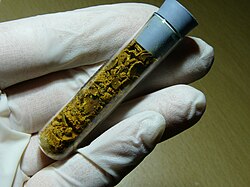
| |

| |
| Identifiers | |
|---|---|
| ChemSpider | |
| ECHA InfoCard | 100.029.078 |
PubChem
CID
|
|
| UNII | |
| |
| Properties | |
| (NH4)2U2O7 | |
| Molar mass | 624.129 g·mol−1 |
Except where otherwise noted, data are given for materials in their
standard state (at 25 °C [77 °F], 100 kPa).
| |
Ammonium diuranate or (ADU) ((NH4)2U2O7), is one of the intermediate chemical forms of
uranium produced during
yellowcake production. The name "yellowcake" originally given to this bright yellow salt, now applies to mixtures of uranium oxides which are actually hardly ever yellow. It also is an intermediate in mixed-oxide (
MOX) fuel fabrication. Although it is usually called "ammonium diuranate" as though it has a "diuranate" ion U
2O2−
7, this is not necessarily the case. It can also be called diammonium diuranium heptaoxide. The structure is said to be similar to that of
uranium dioxide dihydrate.
[1]
[2]
It is precipitated by adding aqueous ammonium hydroxide after uranium extraction by tertiary amines in kerosene. This precipitate is then thickened and centrifuged before being calcined to uranium oxide. Canadian practice favours the production of uranium oxide from ammonium diuranate, rather than from uranyl nitrate as is the case elsewhere.[ citation needed]
Ammonium diuranate was once used to produce colored glazes in ceramics. [3] However when being fired this will decompose to uranium oxide, so the uranate was only used as a lower cost material than the fully purified uranium oxide.
References
-
^ C. N. Turcanu & R. Deju (May 10, 2017). "Thermal Analysis of Ammonium Diuranate". Nuclear Technology. 45 (2): 188–192.
doi:
10.13182/NT79-A32310.
All types of ADU when analyzed by x-ray diffraction have a structure similar to UO3-2H2O
-
^ C. N. Turcanu; et al. (Apr 1976).
"Analiza termica a diuranatului de amoniu" (PDF).
Analiza cu raze X arată pentru ADU o structură cristalină apropiată de UO3·2H2O
{{ cite journal}}: Cite journal requires|journal=( help), citing J. B. Ainscough, B. W. Oldfield (Sep 1962). "Effect of ammonium diuranate precipitation conditions on the characteristics and sintering behaviour of uranium dioxide". Journal of Applied Chemistry. 12 (9): 418–424. doi: 10.1002/jctb.5010120907. and E.H.P.Cordfunke (Mar 1962). "On the uranates of ammonium—I: The ternary system NH3-UO3-H2O". Journal of Inorganic and Nuclear Chemistry. 24. doi: 10.1016/0022-1902(62)80184-5. - ^ Safford, Hurd W.; Kuebel, A. (1943-02-01). "Preparations and properties of ammonium diuranate". Journal of Chemical Education. 20 (2): 88. Bibcode: 1943JChEd..20...88S. doi: 10.1021/ed020p88. ISSN 0021-9584.